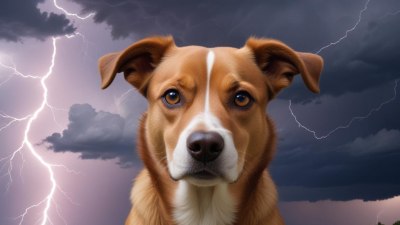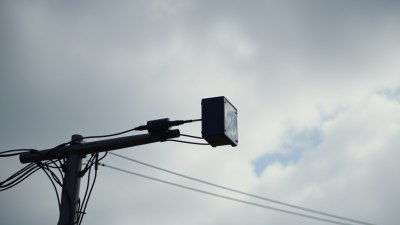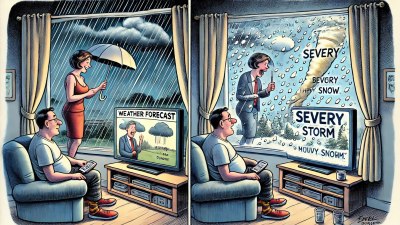The Science of Why Dogs Lose Their Minds Before a Thunderstorm
Explore the reasons behind dogs' anxiety during thunderstorms and how to help them cope.

This image was created with the assistance of Freepik
Many dog owners have experienced the phenomenon of their furry friends becoming increasingly anxious and agitated before a thunderstorm. It’s a sight that prompts concern and frustration, leaving many to wonder what drives this behavior. Understanding the science behind why dogs lose their minds before a thunderstorm requires delving into their senses, instincts, and emotional responses.
Understanding Dog Senses
To grasp the origins of a dog's fear during thunderstorms, one must first understand their heightened senses. Dogs have a keen sense of hearing that is significantly more acute than that of humans. Sounds that we might find irrelevant, like the low rumble of thunder or even the distant sound of lightning, are amplified for them. Scientifically, it is known that dogs can hear frequencies up to 65,000 Hz compared to a human's upper limit of about 20,000 Hz.
This extraordinary sensitivity to sound means that a dog might perceive the booms of thunder long before humans notice any sign of a storm. Furthermore, dogs can also detect barometric pressure changes, which often precede thunderstorms. The drop in atmospheric pressure triggers instinctual responses, as it can signify impending danger in the animal kingdom. This sensitivity to environmental changes can evoke anxiety in some dogs, leading to the frantic behavior we often witness.
Fear and Anxiety in Dogs
Fear and anxiety are natural responses in dogs, and various factors contribute to their intensity. Previous experiences play a significant role; dogs that have been exposed to frightening situations associated with storms may develop a long-term aversion. For instance, if a dog had a traumatic experience during a storm, such as being left outside, it might associate thunderstorms with fear and danger.
Additionally, the individual temperament of a dog further determines their reaction to thunderstorms. Some breeds, such as Border Collies and German Shepherds, tend to be more sensitive, while others are more resilient. Anxiety in dogs manifests in various ways, including panting, pacing, barking, trembling, and seeking comfort from their owners. Understanding your dog's specific triggers and responses is critical for management.
The Role of Lightning and Thunder
The loud crack of thunder and the flash of lightning can also be traumatic for dogs. Thunder can create vibrations that dogs feel through their paws; this phenomenon can add to their unease. Lightning, on the other hand, can startle them due to its bright flash and sudden appearance. These two factors combined create a sensory overload for dogs, tapping into an instinctual fear that triggers a flight response.
A notable aspect of canine behavior is that some dogs exhibit signs of anxiety before the storm even hits. The pre-storm environment may signal danger to a dog, including darkening skies or changes in humidity. This is a time when owners might witness increased barking, hiding, or clinginess to their owners—the dog's instinctual way of seeking safety during perceived threats.
Genetic Predisposition and Behavioral Traits
Genetics can also play a role in a dog's anxiety levels regarding thunderstorms. Research indicates that breeds that were historically bred for herding, guarding, or hunting can be more prone to anxiety due to their heightened instincts. These dogs often have stronger emotional responses and a desire to protect their owners or themselves from perceived threats. Conversely, more relaxed breeds may be better equipped to handle noise and environmental changes without succumbing to panic.
Moreover, the dog's background can highly influence its response to thunderstorms. Dogs that have been socialized well and introduced to a variety of experiences may be less likely to develop storm phobia than those that haven't. This exposure during critical developmental stages helps them learn that thunderstorms are a normal part of life.
Environmental and Psychological Factors
More than just instinct, environmental factors can contribute to a dog's anxiety during thunderstorms. A loving home where the dog feels secure and safe can help mitigate fears. Stressful situations, like moving to a new environment or the loss of a family member, can heighten sensitivity to storms, resulting in behavioral issues.
Psychologically speaking, dogs are attuned to human emotions. If an owner displays anxiety or distress, their dog may sense this and mirror those feelings. On the contrary, dogs that have a calm handler during storms may be more likely to remain relaxed. It's vital to maintain a calm demeanor and provide reassurance during thunderstorms to avoid reinforcing anxious behaviors.
Recognizing the Signs of Anxiety
Before creating a plan to alleviate anxiety, it’s essential to recognize the signs. Dogs may exhibit both subtle and overt signs of distress. Behavior that may require attention includes excessive barking, hiding, chewing, pacing, attempting to escape, excessive licking, or destruction of household items. Understanding your dog's unique cues will help you keep a close eye on their well-being.
Strategies for Managing Thunderstorm Anxiety
There are several strategies that owners can adopt to help their dogs cope with storm anxiety. Creating a safe space can be an effective method—this might be a quiet room free from windows where your dog can feel secure. Some owners also employ calming aids such as specifically designed thunder jackets, herbal supplements, or pheromone diffusers to soothe their pets.
Counterconditioning is another technique that can be helpful. This involves creating positive associations with the sounds of thunder through gradual exposure combined with treats or play. Gradually desensitizing your dog to the sound of thunder, for example, may help reduce anxiety over time.
Professional Help and Training
In cases where anxiety is particularly severe, consulting with a veterinarian, trainer, or pet behaviorist can provide more tailored solutions and behavioral modification techniques. They can help identify specific anxieties and recommend a comprehensive treatment plan that may include behavioral therapy or medications.
Medications prescribed for anxiety should be considered a last resort, but they can be beneficial in some cases to help relax an extremely anxious dog. These medications can make the dog more receptive to training and behavioral modification techniques.
Creating a Calming Environment
Establishing a calming environment can also significantly impact a dog's ability to cope with thunderstorms. Simple strategies such as providing a cozy blanket, playing gentle music, or using a white noise machine can help drown out the sound of thunder. The use of treats during calming exercises may also encourage a more relaxed state.
Routine and predictability can influence a dog’s anxiety levels. Maintaining daily routines for feeding, walking, and playing can provide a sense of stability amidst the chaos of a thunderstorm. This familiarity can effectively alleviate anxiety in some dogs.
Understanding the science behind why dogs lose their minds before thunderstorms emphasizes the importance of empathy and patience. Thunderstorm anxiety is a complex issue influenced by genetic, psychological, and environmental factors. Recognizing and responding appropriately to your dog’s needs during these times can foster a more supportive and nurturing environment, ensuring that they feel safe and loved. Through thoughtful approaches and proper management techniques, many dogs can learn to cope better with thunderstorms and dramatically improve their quality of life.











